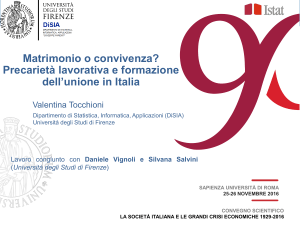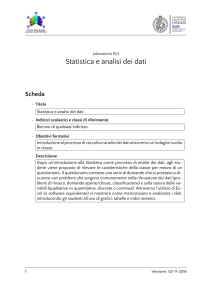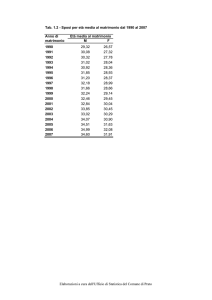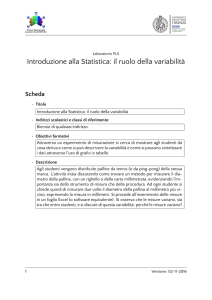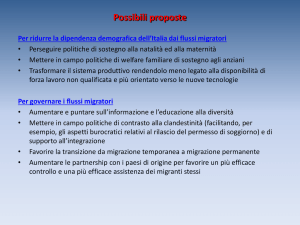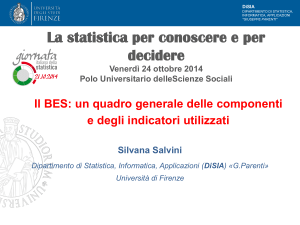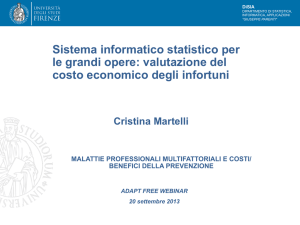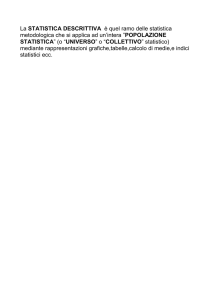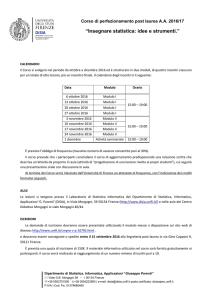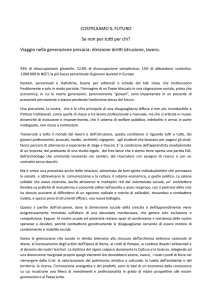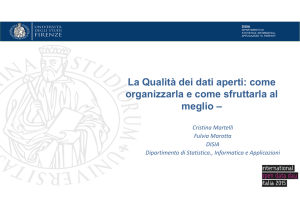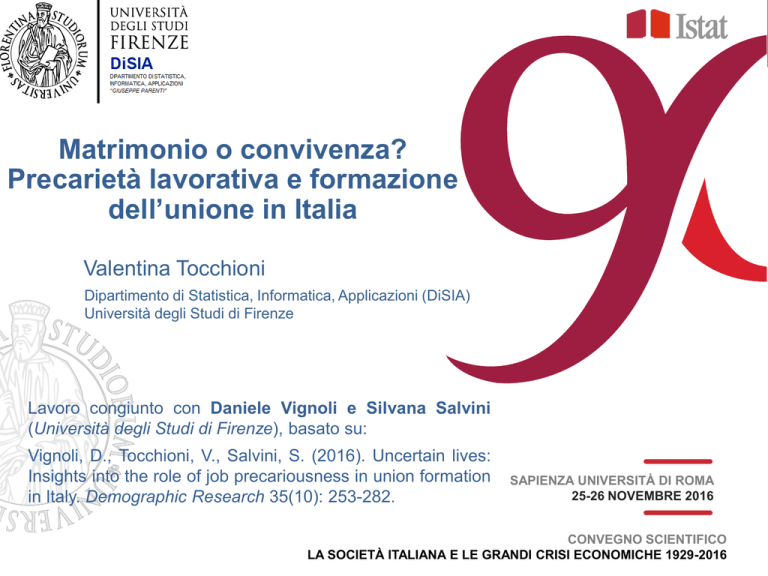
DiSIA
DIPARTIMENTO DI STATISTICA,
INFORMATICA, APPLICAZIONI
"GIUSEPPE PARENTI"
Matrimonio o convivenza?
Precarietà lavorativa e formazione
dell’unione in Italia
Valentina Tocchioni
Dipartimento di Statistica, Informatica, Applicazioni (DiSIA)
Università degli Studi di Firenze
Lavoro congiunto con Daniele Vignoli e Silvana Salvini
(Università degli Studi di Firenze), basato su:
Vignoli, D., Tocchioni, V., Salvini, S. (2016). Uncertain lives:
Insights into the role of job precariousness in union formation
in Italy. Demographic Research 35(10): 253-282.
SAPIENZA UNIVERSITÀ DI ROMA
25-26 NOVEMBRE 2016
CONVEGNO SCIENTIFICO
LA SOCIETÀ ITALIANA E LE GRANDI CRISI ECONOMICHE 1929-2016
Matrimonio o convivenza?
Precarietà lavorativa e formazione dell’unione in Italia
DiSIA
DIPARTIMENTO DI STATISTICA,
INFORMATICA, APPLICAZIONI
"GIUSEPPE PARENTI"
The spread of employment uncertainty
•
The diffusion of new forms of flexible and temporary work contracts
has transformed labor market entry and exit conditions, leading to
an increasing instability of employment careers.
•
This situation has led to a greater risk of economic hardship
and a less predictable future among young people.
•
These uncertainties have spread into the partnership and
parenthood domains of their lives as well (e.g., Mills and
Blossfeld 2005; Blossfeld et al. 2005; Blossfeld et al. 2006;
Blossfeld and Hofmeister 2006; Kreyelfeld et al. 2012;
Vignoli et al. 2012; Vignoli et al. 2013).
2
Matrimonio o convivenza?
Precarietà lavorativa e formazione dell’unione in Italia
DiSIA
DIPARTIMENTO DI STATISTICA,
INFORMATICA, APPLICAZIONI
"GIUSEPPE PARENTI"
Marriage, cohabitation, and job precariousness
•
When social disorganization or blocked opportunities prevail, societal
norms on the “right order” of the life course may lose ground
(Bauman 2005) and a “pattern of disadvantage” might emerge
(Perelli-Harris and Gerber 2011).
•
In these situations, the greater temporary and reversible nature of
cohabitation may provide a living situation that reflects uncertainties
resulting from job instability or prolonged edu-cation (Perelli-Harris et
al. 2010).
•
Furthermore, the spread of job precariousness jeopardizes financial
resources, and may act as a barrier to marriage or a wedding
ceremony (Livi Bacci 2008).
•
The choice of an informal union might be more cost-intensive as
parents tend to withdraw from supporting their adult children (Di
Giulio and Rosina 2007; Schröder 2006).
3
Matrimonio o convivenza?
Precarietà lavorativa e formazione dell’unione in Italia
DiSIA
DIPARTIMENTO DI STATISTICA,
INFORMATICA, APPLICAZIONI
"GIUSEPPE PARENTI"
The Italian setting
•
The major steps in the process of labor market deregulation was
made in 1997, through the Legge Treu (n. 196/1997), while the
following Legge Biagi (n.30/2003) gave further impulse to the
spread of atypical forms of employment.
•
The growth of atypical jobs has increased labor market dualism
between workers finding permanent jobs and those failing to do
so (Ichino et al. 2005).
•
In 2012, the number of workers with temporary jobs amounts to
more than 2 millions (with an increase of more than 20%
compared to 2008).
In parallel, in the period 2008-2012, the labor market faced a
contraction of about 1 million of workers.
4
Matrimonio o convivenza?
Precarietà lavorativa e formazione dell’unione in Italia
DiSIA
DIPARTIMENTO DI STATISTICA,
INFORMATICA, APPLICAZIONI
"GIUSEPPE PARENTI"
Aim and research strategy
•
To provide some fresh insights into the influence of job
precariousness on individuals’ decision to enter cohabitation
or marriage in Italy.
•
We combine the empirical evidence from both qualitative and
quantitative research.
The qualitative analysis provides an in-depth understanding into
the mechanisms of how uncertain forms of employment and
atypical jobs may affect the individual decisions on union
formation.
The quantitative analysis verifies how strong these mechanisms
are in the general population.
5
Matrimonio o convivenza?
Precarietà lavorativa e formazione dell’unione in Italia
DiSIA
DIPARTIMENTO DI STATISTICA,
INFORMATICA, APPLICAZIONI
"GIUSEPPE PARENTI"
Qualitative analysis
•
Qualitative data collected in the project “Childbearing Within
Cohabitation” coordinated by Brienna Perelli-Harris at University of
Southampton.
•
Focus group interviews (FGIs) conducted in February-April 2012 in
Italy (Florence) on individuals aged 25-40.
•
In total, eight FGIs stratified by gender and level of education, were
conducted, with 58 respondents altogether.
•
We applied bottom-up coding procedures to identify main themes.
The categories were systematically compared to investigate
mechanisms through which job precariousness intertwine
with the relationship choices.
6
Matrimonio o convivenza?
Precarietà lavorativa e formazione dell’unione in Italia
DiSIA
DIPARTIMENTO DI STATISTICA,
INFORMATICA, APPLICAZIONI
"GIUSEPPE PARENTI"
Qualitative findings
•
Uncertainty in the labor market is associated with uncertainty in the
private life by respondents essentially through two main mechanisms:
Cohabiting may be seen as a “trouble-free opportunity” to test the
functioning of a relationship; it represents “a sort of test”.
Cohabitation is attracting because it is “easier to disrupt”.
•
When both partners reached a permanent employment status, then
the “right time” to reach a permanent status also in their relationship
seems to follow soon after:
“Lavoro stabile per lui, lavoro stabile per me, 4 mesi dopo ci siamo sposati, 9
mesi dopo ero incinta….eravamo pronti! Cioè: finalmente abbiamo qualche
protezione, qualche diritto!”
(FG 1: W, high education)
7
Matrimonio o convivenza?
Precarietà lavorativa e formazione dell’unione in Italia
DiSIA
DIPARTIMENTO DI STATISTICA,
INFORMATICA, APPLICAZIONI
"GIUSEPPE PARENTI"
Qualitative findings
•
Job precariousness intensifies the difficulties experienced by the young
in their transition to adulthood, when they start their employment
careers, try to strengthen their economic position, and begin to
consider family formation:
“[Il momento giusto per sposarsi arriva con] il lavoro fisso! Dal mio punto di
vista, di persona che a 32 anni continua ad avere contratti di un anno uno
dietro a quell’altro, [puoi sposarti] quando hai un punto fermo.”
(FG1: W, high education)
“Se hai un lavoro permanente, allora puoi anche fare una scelta permanente:
sposarsi!”
(FG2: M, high education)
8
Matrimonio o convivenza?
Precarietà lavorativa e formazione dell’unione in Italia
DiSIA
DIPARTIMENTO DI STATISTICA,
INFORMATICA, APPLICAZIONI
"GIUSEPPE PARENTI"
Quantitative analysis
•
Data: 2009 Household Multipurpose Survey Family & Social Subjects
It covers partnership and employment histories – including information on
changes in the type of contract in each employment spell (with the month
as time unit).
N: 10,304 men and 10,675 women born between 1950 and 1985.
•
Method: Competing risk event-history analysis
We study the transition to the first union for men and women.
Key explanatory (time-varying) variable:
o not employed
o permanent employment
o self-employment
o temporary employment
o atypical job
Confounders: educational attainment, calendar time, and macroarea.
9
Matrimonio o convivenza?
Precarietà lavorativa e formazione dell’unione in Italia
DiSIA
DIPARTIMENTO DI STATISTICA,
INFORMATICA, APPLICAZIONI
"GIUSEPPE PARENTI"
Quantitative results – WOMEN
10
Matrimonio o convivenza?
Precarietà lavorativa e formazione dell’unione in Italia
DiSIA
DIPARTIMENTO DI STATISTICA,
INFORMATICA, APPLICAZIONI
"GIUSEPPE PARENTI"
Quantitative results – MEN
11
DiSIA
Matrimonio o convivenza?
Precarietà lavorativa e formazione dell’unione in Italia
DIPARTIMENTO DI STATISTICA,
INFORMATICA, APPLICAZIONI
"GIUSEPPE PARENTI"
Relative risks of entry into marriage and cohabitation
by employment status in Italy for women.
Results of a piecewise-constant event history
competing risk model.
Entry into marriage
Employment
hazard ratio
covariate
permanent
employment
1.000
not
employed
1.035
temporary
employment
0.768
atypical job
selfemployment
std error
Entry into cohabitation
p-value
hazard ratio
std error
p-value
1.000
0.040
0.375
0.861
0.095
0.175
0.043
0.000
1.215
0.192
0.218
0.779
0.124
0.117
1.447
0.281
0.057
0.947
0.053
0.336
1.161
0.098
0.078
12
DiSIA
Matrimonio o convivenza?
Precarietà lavorativa e formazione dell’unione in Italia
DIPARTIMENTO DI STATISTICA,
INFORMATICA, APPLICAZIONI
"GIUSEPPE PARENTI"
Relative risks of entry into marriage and cohabitation
by employment status in Italy for men.
Results of a piecewise-constant event history
competing risk model.
Entry into marriage
Employment
hazard ratio
covariate
permanent
employment
1.000
not
employed
temporary
employment
atypical job
selfemployment
std error
Entry into cohabitation
p-value
hazard ratio
std error
p-value
1.000
0.389
0.025
0.000
0.676
0.054
0.000
0.727
0.038
0.000
1.142
0.110
0.167
0.657
0.124
0.026
0.973
0.265
0.919
0.972
0.034
0.423
1.105
0.090
0.223
13
Matrimonio o convivenza?
Precarietà lavorativa e formazione dell’unione in Italia
DiSIA
DIPARTIMENTO DI STATISTICA,
INFORMATICA, APPLICAZIONI
"GIUSEPPE PARENTI"
Concluding remarks
•
Our results suggest that cohabitation can be linked to the
growing labor market uncertainty while marriage to
stability
•
In line with those who advocate the emergence of a “pattern of
disadvantage” (Perelli-Harris and Gerber 2011), individuals
faced with blocked opportunities might prefer cohabitation to
marriage, or postponing marriage to periods when their outlook
on life is brighter
•
Given the contemporary developments in terms of
economic fluctuations in Europe, the spread of labor market
uncertainty will likely become increasingly crucial in directing the
choice of the type of union in the years to come.
14
DiSIA
DIPARTIMENTO DI STATISTICA,
INFORMATICA, APPLICAZIONI
"GIUSEPPE PARENTI"
Grazie!
[email protected]
SAPIENZA UNIVERSITÀ DI ROMA
25-26 NOVEMBRE 2016
CONVEGNO SCIENTIFICO
LA SOCIETÀ ITALIANA E LE GRANDI CRISI ECONOMICHE 1929-2016

